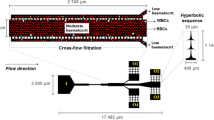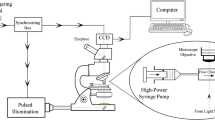Abstract
The deformability of the red blood cell (RBC), is known to be closely related to microcirculation and diagnosis of specific diseases such as malaria, arterial sclerosis, sepsis, and so on. From the viewpoint of the flow type, conventional methods to measure the cell deformability have exploited simple shear or complex flow field with little focus on extensional flow field. In this paper, we present a new approach to assess cell deformability under the extensional flow field. For this purpose, a hyperbolic converging microchannel was designed, and the cell deformation in the extensional flow region was continuously monitored. It overcomes the limitation of conventional methods by reducing experiment time. As quantified by the degree of deformation, the extensional flow (Deformation Index = 0.51 at 3.0 Pa) was found to be more efficient in inducing cell deformation compared to the shear flow (Deformation Index = 0.29 at 3.0 Pa). This indicates the insufficiency of the existing models that predict the blood damage in artificial organs, which only consider shear flow. Also, this method could detect the heat-induced difference in deformability of RBCs. It provides a new platform to study the clinical effect of RBC deformability under extensional flow, and is expected to contribute the association of several diseases and deformability of RBCs.





Similar content being viewed by others
References
D. Arora, M. Behr, M. Pasquali, Artif. Organs 28, 1002 (2004)
H.A. Barnes, A handbook of elementary rheology (The University of Wales Institute of Non-Newtonian Fluid Mechanics, Wales, 2000), pp. 151–163
P.L. Blackshear, G.L. Blackshear, Handbook of bioengineering (McGraw-Hill, New York, 1987), pp. 15.1–15.19
M.C. Dao, T. Lim, S. Suresh, J. Mech. Phys. Solids 51, 2259 (2003)
J.M. Dealy, K.F. Wissbrun, Melt rheology and its role in plastics processing (Nostrand Reinhold, New York, 1990), pp. 231–268
V. Delinder, A. Groisman, Anal. Chem. 78, 3765 (2006)
J.G. Dobbe, G.J. Streekstra, M.R. Hardeman, C. Ince, C. Grimbergen, Cytometry 50, 313 (2002)
E. Evans, Biophys. J. 43, 27 (1983)
F. Feigl, F.X. Tanner, B.J. Edwards, J.R. Collier, J. Non-Newtonian Fluid Mech. 115, 191 (2003)
M.T. Fisher, R.B. Wenby, H.J. Meiselman, Biorheology 29, 185 (1992)
M. Gierspiepen, L.J. Wurzinger, R. Opitz, H. Reul, Int. J. Artif Organs 13, 300 (1990)
M.S. Grant, J. Emerg. Nurs. 29, 116 (2003)
M. Grigioni, C. Daiele, U. Morbiducci, G. D’avenio, G. Benedetto, V. Barbaro, Artif. Organs 28, 467 (2004)
D.S. Kim, S.H. Lee, C.H. Ahn, J.Y. Lee, T.H. Kwon, Labchip 6, 794 (2006)
C. Mobuchon, P.J. Carreau, M. Heuzey, M. Sepehr, Polym. Compos. 26, 247 (2005)
F.C. Mokken, M. Kedaria, C.P. Henny, M.R. Hardeman, A.A. Gelb, Ann. Hematol. 64, 113 (1992)
M. Paulitschke, G.B. Nash, Clin. Hemorheol. Microcirc. 13, 407 (1993)
G.C. Randall, K.M. Schultz, P.S. Doyle, Labchip 6, 516 (2006)
M.K. Sharp, S.F. Mohammad, Ann. Biomed. Eng. 26, 788 (1998)
S. Simchon, K.M. Jan, S. Chien, Am. J. Physiol. 253, 893 (1987)
R. Suwanarusk, B.M. Cooke, A.M. Dondorp, K. Silamut, J. Sattabongkot, N.J. White, R. Udomsangpetch, J. Infect. Dis. 189, 190 (2004)
F.T. Trouton, Proc. Royal Soc. 77A, 426–440 (1906)
M. Umezu, Proceedings of the ASME International Mechanical Engineering Congress and Exposition (ASME advances in bioengineering). 28, 33 (1994)
Y.N. Xia, G.M. Whitesides, Angew. Chem. Int. Edit. 37, 551 (1998)
S. Yang, A. Undar, J.D. Zahn, Labchip. 6, 871–880 (2006)
Acknowledgements
This work was supported by the National Research Laboratory Fund (M10300000159) of the Ministry of Science and Technology in Korea. We appreciate M. C. Kang and S. Oh for generous help with microfabrication process and for manufacturing microfluidic devices. We also appreciate J. H. Lee from Institute of Laboratory Animal Resources in Seoul National University for collecting rabbit blood.
Author information
Authors and Affiliations
Corresponding author
Rights and permissions
About this article
Cite this article
Lee, S.S., Yim, Y., Ahn, K.H. et al. Extensional flow-based assessment of red blood cell deformability using hyperbolic converging microchannel. Biomed Microdevices 11, 1021 (2009). https://doi.org/10.1007/s10544-009-9319-3
Published:
DOI: https://doi.org/10.1007/s10544-009-9319-3




